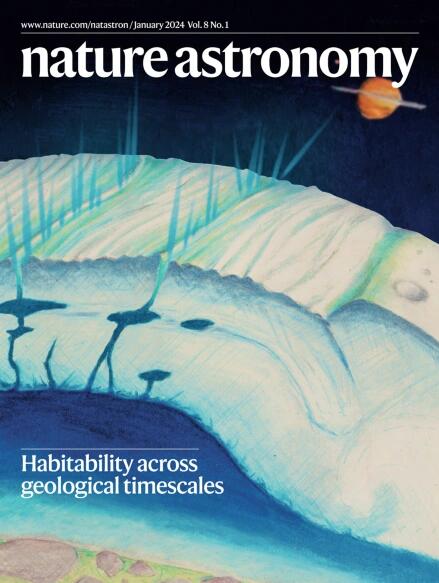干燥的金星内部受到大气化学的限制
IF 12.9
1区 物理与天体物理
Q1 ASTRONOMY & ASTROPHYSICS
引用次数: 0
摘要
金星的气候历史对液态水宜居带内缘的位置提供了强有力的限制。然而,金星上的水有两种截然不同的历史:一种是在数十亿年的时间里,金星的气候温和,表面有液态水;另一种是在炎热的早期金星从来没有凝结过表面液态水。在这里,我们通过推断金星内部的水含量,对金星的气候历史提供了一个限制。通过计算目前大气中H2O、CO2和OCS的破坏速率,我们发现金星的内部是干燥的,这些物质必须通过火山活动来恢复,以保持大气的稳定。金星的火山气体最多只有6%的水摩尔分数,这比在类似条件下脱气的地球岩浆要干燥得多。干燥的内部与金星在岩浆海洋时代结束时的干燥一致,此后有一个长期的干燥表面。因此,火山对金星大气的补充表明,金星上从来就没有液态水适宜居住。本文章由计算机程序翻译,如有差异,请以英文原文为准。


A dry Venusian interior constrained by atmospheric chemistry
Venus’s climatic history provides powerful constraints on the location of the inner edge of the liquid-water habitable zone. However, two very different histories of water on Venus have been proposed: one where Venus had a temperate climate for billions of years with surface liquid water and the other where a hot early Venus was never able to condense surface liquid water. Here we offer a constraint on Venus’s climate history by inferring the water content of its interior. By calculating the present rate of atmospheric destruction of H2O, CO2 and OCS, which must be restored by volcanism to maintain atmospheric stability, we show that Venus’s interior is dry. Venusian volcanic gases have at most a 6% water mole fraction, which is substantially drier than terrestrial magmas degassed at similar conditions. The dry interior is consistent with Venus ending its magma ocean epoch desiccated and thereafter having had a long-lived dry surface. Volcanic resupply to Venus’s atmosphere, therefore, indicates that the planet has never been liquid-water habitable. The composition of the volcanic gas supplied to Venus’s atmosphere indicates that the planet has a dry interior and is unlikely to have condensed liquid water on its surface, substantially constraining its potential habitability.
求助全文
通过发布文献求助,成功后即可免费获取论文全文。
去求助
来源期刊

Nature Astronomy
Physics and Astronomy-Astronomy and Astrophysics
CiteScore
19.50
自引率
2.80%
发文量
252
期刊介绍:
Nature Astronomy, the oldest science, has played a significant role in the history of Nature. Throughout the years, pioneering discoveries such as the first quasar, exoplanet, and understanding of spiral nebulae have been reported in the journal. With the introduction of Nature Astronomy, the field now receives expanded coverage, welcoming research in astronomy, astrophysics, and planetary science. The primary objective is to encourage closer collaboration among researchers in these related areas.
Similar to other journals under the Nature brand, Nature Astronomy boasts a devoted team of professional editors, ensuring fairness and rigorous peer-review processes. The journal maintains high standards in copy-editing and production, ensuring timely publication and editorial independence.
In addition to original research, Nature Astronomy publishes a wide range of content, including Comments, Reviews, News and Views, Features, and Correspondence. This diverse collection covers various disciplines within astronomy and includes contributions from a diverse range of voices.
 求助内容:
求助内容: 应助结果提醒方式:
应助结果提醒方式:


